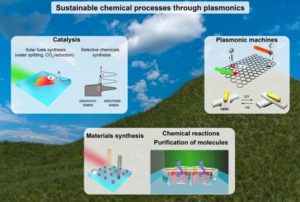Applying plasmonics to a sustainable future
 Chemistry is fundamental for powering our society and plasmonics may have a transformative impact on the way we will drive, manipulate, enhance, and monitor chemical processes in the future. In our recent Perspective published in Science in collaboration with pioneers in the field of plasmonics such as Prof. Shalaev (Purdue University) and Prof. Brongersma (Stanford University), we discuss how hot-carrier driven transformations on metal surfaces offer the opportunity for exploring new types of chemistry that are typically only possible at high temperatures and pressures. Further potential for utilizing surface plasmons in chemistry is the intense local heating generated by the coupling of the electron density wave to lattice vibrations. This heating can be localized in space and time, offering the opportunity for running chemistry with enhanced energy efficiency and without the need of macroscopic heat sources for heating supporting materials or for vaporizing chemical species. Some interesting applications include thermally-stimulated catalysis, plasmon-enhanced chemical vapor deposition for the growth of nanostructures, water purification, separation of chemicals, and solar distillation. Another exciting possibility is to create plasmonic machines capable of making smart operations such as transport of molecules, information processing, or even more complex tasks. In our view, high-performance plasmonic materials will be central in the development of ultrathin and efficient portable device, which would have a strong impact on the decentralized production of fuels and chemicals. The transition to a clean and sustainable society is already taking place. Plasmonics can help accelerate this changeover by enabling, manipulating, enhancing, and monitoring chemical processes with atomic-scale precision and control.
Chemistry is fundamental for powering our society and plasmonics may have a transformative impact on the way we will drive, manipulate, enhance, and monitor chemical processes in the future. In our recent Perspective published in Science in collaboration with pioneers in the field of plasmonics such as Prof. Shalaev (Purdue University) and Prof. Brongersma (Stanford University), we discuss how hot-carrier driven transformations on metal surfaces offer the opportunity for exploring new types of chemistry that are typically only possible at high temperatures and pressures. Further potential for utilizing surface plasmons in chemistry is the intense local heating generated by the coupling of the electron density wave to lattice vibrations. This heating can be localized in space and time, offering the opportunity for running chemistry with enhanced energy efficiency and without the need of macroscopic heat sources for heating supporting materials or for vaporizing chemical species. Some interesting applications include thermally-stimulated catalysis, plasmon-enhanced chemical vapor deposition for the growth of nanostructures, water purification, separation of chemicals, and solar distillation. Another exciting possibility is to create plasmonic machines capable of making smart operations such as transport of molecules, information processing, or even more complex tasks. In our view, high-performance plasmonic materials will be central in the development of ultrathin and efficient portable device, which would have a strong impact on the decentralized production of fuels and chemicals. The transition to a clean and sustainable society is already taking place. Plasmonics can help accelerate this changeover by enabling, manipulating, enhancing, and monitoring chemical processes with atomic-scale precision and control.
A. Naldoni, V. M. Shalaev, M. L. Brongersma “Applying plasmonics to a sustainable future”, Science 2017, 356, 908 – 909.


